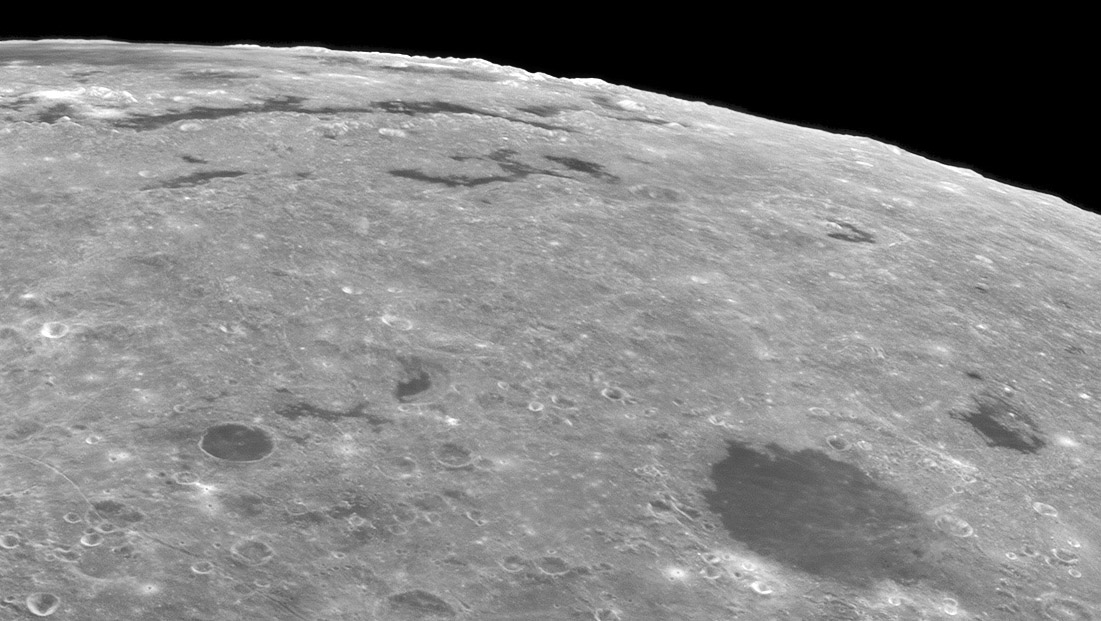Difference between revisions of "August 8, 2010"
| Line 3: | Line 3: | ||
<!-- ws:start:WikiTextHeadingRule:1:<h1> --> | <!-- ws:start:WikiTextHeadingRule:1:<h1> --> | ||
<!-- ws:start:WikiTextLocalImageRule:16:<img src="/file/view/Aug8-10.jpg/155570167/Aug8-10.jpg" alt="" title="" /> -->[[File:Aug8-10.jpg|Aug8-10.jpg]]<!-- ws:end:WikiTextLocalImageRule:16 --><br /> | <!-- ws:start:WikiTextLocalImageRule:16:<img src="/file/view/Aug8-10.jpg/155570167/Aug8-10.jpg" alt="" title="" /> -->[[File:Aug8-10.jpg|Aug8-10.jpg]]<!-- ws:end:WikiTextLocalImageRule:16 --><br /> | ||
| − | <em>image by [mailto:bart.declercq@gmail.com | + | <em>image by [mailto:bart.declercq@gmail.com Bart Declercq], Haaltert, Belgium</em><br /> |
<br /> | <br /> | ||
| − | Lunar lavas are generated by melting at depths of 100 km or more. Rising to the surface is difficult unless there are deep fractures. That is why most lavas occur in impact basins, which make the deepest cuts into the lunar crust. Thus, the leaks of lava along the fault scarps of the Rook and Cordillera mountain rings, and in the center of Orientale are expected. And the crescentric patch on the floor of [http://the-moon.wikispaces.com/Schluter Schlüter] at top right is probably lava that rose up a Cordillera fault but escaped just beyond the basin rim. At bottom right the big pond of mare lava is also on the floor of a basin, the Grimaldi Basin. And the dark lava on the floor of Riccioli, farthest to the right, is just inside the main ring of the Grimaldi Basin, in a position analogous to the lavas inside Orientale's rings. Finally, the dark skating ring floor of Crüger, and the puddles of [http://the-moon.wikispaces.com/Lacus+Aestatis Lacus Aestatis] and [http://the-moon.wikispaces.com/file/detail/Rukl_39_satellites_SW.jpg | + | Lunar lavas are generated by melting at depths of 100 km or more. Rising to the surface is difficult unless there are deep fractures. That is why most lavas occur in impact basins, which make the deepest cuts into the lunar crust. Thus, the leaks of lava along the fault scarps of the Rook and Cordillera mountain rings, and in the center of Orientale are expected. And the crescentric patch on the floor of [http://the-moon.wikispaces.com/Schluter Schlüter] at top right is probably lava that rose up a Cordillera fault but escaped just beyond the basin rim. At bottom right the big pond of mare lava is also on the floor of a basin, the Grimaldi Basin. And the dark lava on the floor of Riccioli, farthest to the right, is just inside the main ring of the Grimaldi Basin, in a position analogous to the lavas inside Orientale's rings. Finally, the dark skating ring floor of Crüger, and the puddles of [http://the-moon.wikispaces.com/Lacus+Aestatis Lacus Aestatis] and [http://the-moon.wikispaces.com/file/detail/Rukl_39_satellites_SW.jpg Rocca A] were inexplicable until LPOD revealed the [http://lpod.wikispaces.com/March+7%2C+2010 answer]. <br /> |
<br /> | <br /> | ||
| − | <em>[mailto:tychocrater@yahoo.com | + | <em>[mailto:tychocrater@yahoo.com Chuck Wood]</em><br /> |
<br /> | <br /> | ||
<strong>Technical Details</strong><br /> | <strong>Technical Details</strong><br /> | ||
| Line 16: | Line 16: | ||
<br /> | <br /> | ||
<hr /> | <hr /> | ||
| − | <div>You can support LPOD when you buy any book from Amazon thru [http://www.lpod.org/?page_id=591 | + | <div>You can support LPOD when you buy any book from Amazon thru [http://www.lpod.org/?page_id=591 LPOD!]<br /> |
</div> | </div> | ||
---- | ---- | ||
===COMMENTS?=== | ===COMMENTS?=== | ||
| − | + | Register, and click on the <b>Discussion</b> tab at the top of the page. | |
Revision as of 17:23, 11 January 2015
Leaks

image by Bart Declercq, Haaltert, Belgium
Lunar lavas are generated by melting at depths of 100 km or more. Rising to the surface is difficult unless there are deep fractures. That is why most lavas occur in impact basins, which make the deepest cuts into the lunar crust. Thus, the leaks of lava along the fault scarps of the Rook and Cordillera mountain rings, and in the center of Orientale are expected. And the crescentric patch on the floor of Schlüter at top right is probably lava that rose up a Cordillera fault but escaped just beyond the basin rim. At bottom right the big pond of mare lava is also on the floor of a basin, the Grimaldi Basin. And the dark lava on the floor of Riccioli, farthest to the right, is just inside the main ring of the Grimaldi Basin, in a position analogous to the lavas inside Orientale's rings. Finally, the dark skating ring floor of Crüger, and the puddles of Lacus Aestatis and Rocca A were inexplicable until LPOD revealed the answer.
Chuck Wood
Technical Details
2010-08-03 03h50UT. 30 cm f/5 Newtonian @f/20 + Astronomik red filter +DMK41AF @15 fps
Related Links
Rükl plates 39 & 50
COMMENTS?
Register, and click on the Discussion tab at the top of the page.



